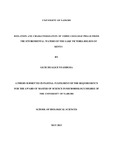| dc.description.abstract | The aim of this study was to isolate bacteriophages able to lyse Vibrio cholerae bacteria that
cause cholera. Vibriophages have been successfully used to control the pathogen in the
environment so as to minimise cholera outbreaks. To isolate bacteriophages lytic against
Vibrio cholerae strain used in this study, sixty seven environmental water samples were
collected. Forty two samples from the Lake Victoria region of Kenya and twenty five from
the Coast region. Sources of the Lake region environmental water samples included ponds,
sewage effluent, rivers, wel1s and lakes. Water samples from the coast region were from
different rivers. To increase the densities of vibriophages in these environmental water
samples, three techniques were employed: filtration, centrifugation and enrichment. Isolation
of vibriophages employed the soft agar overlay technique to carry out plaque assays and spot
assays. Enrichment procedures were carried out for 48 h in broth containing Vibrio cholerae
strain in broth containing at 37°C. The plaques ranged from 16 to 36 pfu/ml after the
enrichment process. These plaques were tiny and clear. The spot assays showed a clear zone - at the spot where lysate was spotted either.at !he centre of a lawn of Vibrio cholerae or a
t· '''; ,
streak of the bacterium signifying zones of cell killing which was indicative of the presence
of vibriophages in the environmental water samples. A total of 5 samples were positive for
plaque assays. To enhance detection of plaques and morphological characterisation of the
vibriophages by transmission electron microscopy, reduction of agar concentration from
0.8% to 0.6 % was adopted in this study. MorPhological characterisatio~ of the vibriophages
by transmission electron microscopy revealed !heir resemblance to Myoviridae family. The
vibriophages had icosahedral shaped head with an average diameter of 88.3nm. A long
contractile tail of length and width 84.9nm and 16.1nm respectively. One monograph showed
a contracted tail. All these phages belonged to one morphotype. The isolated phage was
capable of infecting Vibrio cholerae isolated from the environmental waters of the Lake
Victoria region of Kenya. No phages were isolated from the environmental water samples of
the coast region. Their host is therefore of considerable ecological interest since it causes
cholera especially during heavy rains in Kenya. | en |

